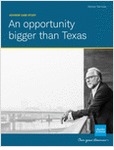The true measure of an active investment manager is more than a beating-the-market track record, longtime hedge fund investor Ted Seides says.
“It’s a combination of process, client base and a deep passion for the business” and more, Seides, founder of Capital Allocators and host of the popular podcast of the same name, tells ThinkAdvisor in an interview.
In 2007, Seides took the active-versus-passive investing debate to an extreme when he famously initiated a non-profitable bet with Warren Buffett pitting the performance of the Vanguard S&P 500 from 2008 to 2017 against five hedge fund of funds products.
Seides assessed his chances of prevailing at 85%, but Buffett emerged the winner. Yet today Seides sticks to his guns: “If you went back to January 1, 2008, and made the same bet over 10 years, I think you’d win seven out of 10 times picking hedge funds,” he argues in the interview.
Seides’ decision process was crucial in that wager, and decision-making is a key part of his new book, “Capital Allocators: How the World’s Elite Money Managers Lead and Invest” (Harriman House- March 23, 2021).
In the interview, Seides, who has run his own hedge fund firm and was profiled in the 2010 book “Top Hedge Fund Investors,” discusses the dismaying reality that all humans are “hardwired to make bad decisions,” as research and behavioral economists have pointed out. However, we can learn to make better decisions by diligently using effective decision-making processes, he emphasizes.
Seides’ book seeks to help folks managing capital — especially fund managers, wealth advisors and investment entrepreneurs — to make better decisions.
It is packed with insights and practical advice not only from him but also other prominent investors and strategists, like Annie Duke, Morgan Housel and Patrick O’Shaughnessy, whose words of wisdom Seides gleaned from the first 150 episodes of his critically acclaimed podcast, which attracts 50,000 listeners weekly.
Seides started out in 1992 at the Yale University Investments Office under chief investment officer David Swensen. He later founded Protégé Partners, which invested in and seeded small hedge funds.
Now, with the advisory unit of his firm, Capital Allocators Advisory, he’s helping both money managers and capital allocators “make more money by compounding knowledge and relationships,” according to his website.
In the interview, Seides explains why it’s critical for financial advisors to pay more attention to the truth and universality of behavioral biases and discusses active managers’ penchant for indulging in dreaded style shift.
ThinkAdvisor recently held a phone interview with Seides, who is based in Greenwich, Connecticut. The conversation turned to environmental, social and governance focused investing, which, he noted, has been called a “megatrend.” At this stage, it is focused on environmental issues. “People are now paying attention to the cost of harming the environment,” he noted.
Here are highlights from our interview:
THINKADVISOR: What was your reaction when you lost that famous 10-year bet with Warren Buffett pitting the Vanguard S&P 500 fund against a group of hedge funds?
TED SEIDES: It was a slow-moving loss: He declared victory a year before the bet was over, and I responded by saying he was probably right. But I wanted to think through to see if there was anything in my decision process that could have been improved. So I went back and looked at a paper I’d written at the beginning of the bet documenting exactly why I thought I’d win.
What did you conclude?
I came away thinking I’d probably been a little bit overconfident. But I still thought the odds of success were pretty high. I think the same now. If you went back to January 1, 2008, and made the same bet over 10 years, I think you’d win seven out of ten times picking hedge funds.
“We’re hardwired to make bad decisions,” you write in “Capital Allocators.” What can financial advisors do to try to overcome that?
The first thing is to become self-aware and fully recognize that there are biases that will affect you. There’s a whole set of processes you can create in your decision-making to try be cognizant of [those] in the moment. Ahead of the decision-making process, you can do risk assessment. You can create a journal of what you were thinking at the time, so that after the fact, you can review it and get better at making decisions. And, as Annie Duke [decision strategist, ex-poker champ] says, think in probabilities, not absolutes.
Many financial advisors give behavioral economics short shrift. Why should they pay more attention to it?
Because it’s affecting them. It affects all of us. The set of behavioral biases — like overconfidence, risk aversion, confirmation bias and so on — applies to all those people who are dismissing behavioral economics. They’re probably overconfident in their own ability. That’s not a good thing. No one is immune to behavioral biases. Every investor needs to understand what we’ve learned about behavioral economics to make better decisions going forward.
What are the top principles of investing that you learned from David Swensen when you worked with him at Yale?
Everything I learned about investing I learned from David [such as] the importance of having a very well articulated investment philosophy and strategy, and then the discipline to stick to it.
Is it hard to develop that discipline?
Not to develop it, but it’s hard [to follow it] in real time because of all the behavioral biases and things going wrong, and the way people react to fear that causes them to veer from that discipline. We’ve all made those same mistakes. So it’s a question of learning from mistakes of the past and growing.
Active managers have been outperforming the market less and less over the last several years. What’s required to be a successful active manager?
Successful managers are probably the ones that have successful track records throughout their lives, and not just in investing. They have skills to generate excess returns. They have repeatable processes. They need to have strong businesses. They have to attract and retain talent. They have to have the right temperament and grit. The problem is that all those things describe far more managers that don’t outperform than do.
What’s the special something managers need to outperform?
It’s less the characteristics than a combination of who the people are, what their process is and who their client base is because they must have duration of capital to make it through the inevitable downturns. And they must be deeply passionate about the business.








 April 19, 2021 at 02:17 PM
April 19, 2021 at 02:17 PM












 Copyright © 2024 ALM Global, LLC. All Rights Reserved.
Copyright © 2024 ALM Global, LLC. All Rights Reserved.